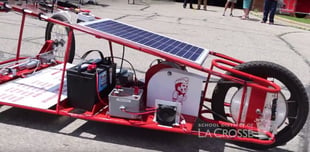Steve Johnston has been a technology and engineering educator for 29 years and has spent the last 21 of those years at Logan High School in La Crosse, Wisconsin. He teaches PLTW Digital Electronics, Cisco Networking, computer construction, robotics, and video projection.
During the 2016-17 school year, students in the PLTW Digital Electronics class and welding fabrication class at La Crosse Logan High School partnered with local business and industry leaders to design and build a Repetitive Work Exoskeleton.
Exoskeletons contain rigid and resistant components that fulfill a set of functional roles – including protection and support – as an assistive technology to improve quality of life and to make work easier. They are fabricated out of steel or aluminum and other materials. The operator controls the speed and flow of the operation.
The purpose of the arm was to take the load of a metal grinder off the operator and transfer it to the exoskeleton to prevent repetitive work injuries and increase productivity. The Exo Arm can grind down welds on various metals from multiple angles.
The students focused on designing, programming, and fabricating an Exo Arm with the following targeted project goals:
1. Engage in an authentic engineering learning experience.
2. Design and fabricate an Exo Arm for a repetitive work-related job (grinding) in manufacturing.
3. Create the device to relieve the tension and lifting forces that a worker experiences with a grinding operation.
The Exo Arm was designed and fabricated at Logan High School in the Technology and Engineering Department. Industrial Automation, Motion Industries, Inc., Schaeffler Group USA, Inc., and Trane provided technical support and materials and helped define the parameters of the project.
The project was funded with a grant from the La Crosse Public Education Foundation (Randy & Judy Eddy Fund), which in recent years has supported PLTW class projects to build remote-operated underwater and aerial vehicles, as well as a self-driving car.
For more information, check out our project links:
PLTW’s blog is intended to serve as a forum for ideas and perspectives from across our network. The opinions expressed are those of each guest author.


